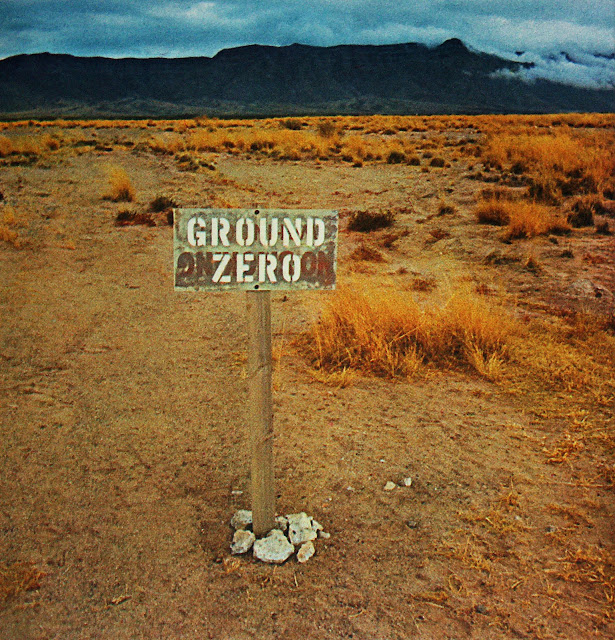“Le fer brûlé. Le fer brisé, le fer devenu vulnérable comme la chair.”
Marguerite Duras, Hiroshima mon amour, 1959/60
[Iron, material of vaunting structures, symbols of progress from an age of optimism. Ironies of history "made vulnerable as flesh."]
“On August 6, 1945 a New Age began: the age in which at any given moment we have the power to transform any given place on our planet, and even our planet itself, into a Hiroshima. On that day we became, at least modo negativo, omnipotent; but since, on the other hand, we can be wiped out at any given moment, we also became totally impotent. However long this age may last, even if it should last forever, it is the “Last Age”: for there is no possibility that its differentia specifica, the possibility of our self-extinction, can ever end – but by the end itself.”
[Iron, material of vaunting structures, symbols of progress from an age of optimism. Ironies of history "made vulnerable as flesh."]
“On August 6, 1945 a New Age began: the age in which at any given moment we have the power to transform any given place on our planet, and even our planet itself, into a Hiroshima. On that day we became, at least modo negativo, omnipotent; but since, on the other hand, we can be wiped out at any given moment, we also became totally impotent. However long this age may last, even if it should last forever, it is the “Last Age”: for there is no possibility that its differentia specifica, the possibility of our self-extinction, can ever end – but by the end itself.”
Günther Anders, “Theses for the Atomic Age,” 1959
Collective denials and evasions still in force, blocking, freezing, blinding. Who wants to know, who has time to know, who has the luxury and attention needed to know – and what would anyone do with such knowledge anyway?
Hiroshima: regrettable necessity of the “Good War” against fascism? That lie was long ago exposed, but the exposure still goes unregistered in the place where it counts.
To think and grasp: the global imperialist context 1914-1945 as a single social process (WWI, Russian Revolution, rising US power, defeat of revolution in Germany, fascism in Italy, crisis and Depression, Stalinism, Nazism, crushing of Spanish Republic, WW2, Auschwitz, Hiroshima).
If Auschwitz and Hiroshima cannot be separated from the global process and master logic of capitalist modernity, as it actually unfolded, then what emerges as decisive is the course of class struggle over those three decades. Above all: the defeat of revolution in the capitalist core (Germany, Italy, Hungary) transforms the Russian Revolution into the state capitalism of “socialism in one country,” setting the stage for both Stalinism and Nazism.
Not to say it could not have happened otherwise. Not to deny that this historical period is complex and contradictory. But to acknowledge and to insist on the pressure of the master logic, behind and in the specific processes of Auschwitz and Hiroshima.
This is what the linkage of Auschwitz and Hiroshima, still so controversial, still so resisted, expresses: not that these event-processes are identical or equivalent, but that they must be grasped and thought together, across their obvious differences. What this “and” says is that both are specific appearance-forms of a single social essence.
And that they in turn transform the way in which this essence will from then on unfold: changing the form of the capitalist state, initiating the normalization of exception. The post-1945, post-Auschwitz, post-Hiroshima global regime: our social reality.
“Crucially, these genocidal techno-administrative forces were developed in a specific global conjuncture of class struggle: they are products of defeats suffered by the exploited and from now on are aimed at the exploited, as the weapons of state terror. That is, they are aimed at humanity itself, at the potential humanity carries in itself to overcome its fears and collective self-oppressions and make the social passage from necessity to freedom.”
Collective denials and evasions still in force, blocking, freezing, blinding. Who wants to know, who has time to know, who has the luxury and attention needed to know – and what would anyone do with such knowledge anyway?
Hiroshima: regrettable necessity of the “Good War” against fascism? That lie was long ago exposed, but the exposure still goes unregistered in the place where it counts.
To think and grasp: the global imperialist context 1914-1945 as a single social process (WWI, Russian Revolution, rising US power, defeat of revolution in Germany, fascism in Italy, crisis and Depression, Stalinism, Nazism, crushing of Spanish Republic, WW2, Auschwitz, Hiroshima).
If Auschwitz and Hiroshima cannot be separated from the global process and master logic of capitalist modernity, as it actually unfolded, then what emerges as decisive is the course of class struggle over those three decades. Above all: the defeat of revolution in the capitalist core (Germany, Italy, Hungary) transforms the Russian Revolution into the state capitalism of “socialism in one country,” setting the stage for both Stalinism and Nazism.
Not to say it could not have happened otherwise. Not to deny that this historical period is complex and contradictory. But to acknowledge and to insist on the pressure of the master logic, behind and in the specific processes of Auschwitz and Hiroshima.
This is what the linkage of Auschwitz and Hiroshima, still so controversial, still so resisted, expresses: not that these event-processes are identical or equivalent, but that they must be grasped and thought together, across their obvious differences. What this “and” says is that both are specific appearance-forms of a single social essence.
And that they in turn transform the way in which this essence will from then on unfold: changing the form of the capitalist state, initiating the normalization of exception. The post-1945, post-Auschwitz, post-Hiroshima global regime: our social reality.
“Crucially, these genocidal techno-administrative forces were developed in a specific global conjuncture of class struggle: they are products of defeats suffered by the exploited and from now on are aimed at the exploited, as the weapons of state terror. That is, they are aimed at humanity itself, at the potential humanity carries in itself to overcome its fears and collective self-oppressions and make the social passage from necessity to freedom.”




In my opinion GULAG is more similar to Auschwitz than Hiroshima.
ReplyDeleteLudwik Kowalski,
The author of an autobiography "Tyranny to Freedom: Diary of a Former Stalinist." The book and reviews are at
amazon [dot] com